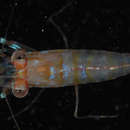Comprehensive Description
provided by Smithsonian Contributions to Zoology
Brachycarpus biunguiculatus (Lucas, 1846)
Palaemon biunguiculatus Lucas, 1846:45, pl. 4: fig. e.
Brachycarpus savignyi Bate,1888:795, pl. 129: fig. 4.
Brachycarpus biunguiculatus.—Chace, 1966:625.
MATERIAL.—Manning 1971 Collection: Sta ASC-9, McArthur Point 1 male [5.1].—Sta ASC-15, English Bay: 1 male [8.3].—Sta ASC-16, Shelly Beach: 1 male [6.8].—Sta ASC-21, English Bay: 2 females [3.1–3.4].—Sta ASC-22, McArthur Point 1 male [3.9], 1 female [3.2].
Smithsonian 1976 Collection: ASC Sta 8, McArthur Point: 1 male [8.2].
Grice Marine Biological Laboratory Collection: Sta 80-43, English Bay,0–1 m: 2 males (GMBL).
Operation Origin: Site 31, Spire Rock, 10 m: 1 ovig. female [10.0].
Other Collections: Olson (1970); McArthur Point, sandy bottom tide pool: 2 males [7.8–10.5].—Jourdan (1977), Long Beach: 1 male [8.6].—Castro (1978), McArthur Point 1 ovig. female [14.3].—Ascension Island, T. Conry: 1 male [6.5] (BMNH 82.1).
SIZE.—Carapace lengths of males, 3.9–10.5 mm; of females, 3.1–14.3 mm; of ovigerous females, 10.0–14.3 mm.
COLOR.—Notes made by Operation Origin personnel indicate that their specimen was orange with black eyes and the chelae were ochre with darker rings.
HABITAT.—Most of the specimens listed above were collected from tide pools.
DISTRIBUTION.—Pantropical and subtropical; eastern Atlantic from the Mediterranean and off West Africa; central Atlantic from Ascension; western Atlantic from Bermuda to Curacao; Clipperton Island, eastern Pacific (Chace, 1962); Indo-West Pacific from Hawaii to Red Sea; littoral and sublittoral.
- bibliographic citation
- Manning, Raymond B. and Chace, Fenner Albert, Jr. 1990. "Decapod and stomatopod crustaceans from Ascension Island, south Atlantic Ocean." Smithsonian Contributions to Zoology. 1-91. https://doi.org/10.5479/si.00810282.503
Comprehensive Description
provided by Smithsonian Contributions to Zoology
Brachycarpus biunguiculatus (Lucas, 1849)
Palaemon biunguiculatus Lucas, 1849:45, pl. 4: fig. 4.
Brachycarpus biunguiculatus (Lucas).—Holthuis, 1952:3, pl. 1—Chace, 1962:606; 1966:625; 1972:18.
MATERIAL.—3 males, 6 non-ovigerous females, 5 ovigerous females, 1 juvenile, Malpelo coll. no. 3; 2 males, 2 non-ovigerous females, Malpelo coll. no. 4.
MEASUREMENTS.—Males tl (including rostrum) 36.1–40.7 mm; non-ovigerous females tl 22.7–28.7 mm; ovigerous females tl 31.5–41.3 mm.
DISTRIBUTION.—This species is circumtropical in distribution occurring on most oceanic islands.
- bibliographic citation
- Graham, Jeffrey B. 1975. "The Biological investigation of Malpelo Island, Colombia." Smithsonian Contributions to Zoology. 1-98. https://doi.org/10.5479/si.00810282.176
Depth range
provided by World Register of Marine Species
Shallow to deep-waters (e.g. 10-190 m)
Poupin, J. (2018). Les Crustacés décapodes des Petites Antilles: Avec de nouvelles observations pour Saint-Martin, la Guadeloupe et la Martinique. Muséum national d'Histoire naturelle, Paris, 264 p. (Patrimoines naturels ; 77).
- license
- cc-by-4.0
- copyright
- WoRMS Editorial Board
Habitat
provided by World Register of Marine Species
Known from seamounts and knolls
Stocks, K. 2009. Seamounts Online: an online information system for seamount biology. Version 2009-1. World Wide Web electronic publication.
- license
- cc-by-4.0
- copyright
- WoRMS Editorial Board
Habitat
provided by World Register of Marine Species
Hard bottom (rock and rubbles)
Poupin, J. (2018). Les Crustacés décapodes des Petites Antilles: Avec de nouvelles observations pour Saint-Martin, la Guadeloupe et la Martinique. Muséum national d'Histoire naturelle, Paris, 264 p. (Patrimoines naturels ; 77).
- license
- cc-by-4.0
- copyright
- WoRMS Editorial Board

